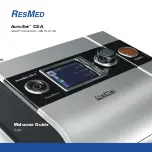
Ph
ilip
s M
e
di
ca
l Sy
st
e
m
s
D-1
D
D
Warnings and precautions
It is important to understand how to use your HeartStart Defibrillator safely.
Please read these warnings and precautions carefully.
A
warning
describes something that could cause serious personal injury or death.
A
precaution
describes something that could cause minor personal injury,
damage to the HeartStart, loss of data stored in the HeartStart, or less chance of
successful defibrillation.
NOTE: The HeartStart Defibrillator is designed to be used only with Philips-
approved accessories. The HeartStart may perform improperly if non-
approved accessories are used.
Warnings
flammable gases
If the HeartStart is used to give a shock in the presence of flammable gases such as
in an oxygen tent, there is a risk of explosion. Move supplemental oxygen and
oxygen delivery devices away from the defibrillation pads. (However, it is safe to
use the HeartStart on someone wearing an oxygen mask.)
battery
The HeartStart M5070A battery is not rechargeable. Do not try to recharge,
open, crush, or burn the battery, or it may explode or catch fire.
fluids
Do not let fluids get into the HeartStart. Avoid spilling any fluids on the HeartStart
or its accessories. Spilling fluids into the HeartStart may damage it or cause a fire
or shock hazard. Do not sterilize the HeartStart or its accessories.
accessories
Using damaged or expired equipment or accessories may cause the HeartStart
Defibrillator to perform improperly, and/or injure the patient or the user.
patient handling
Performing CPR or otherwise handling or moving the patient while the HeartStart
is analyzing heart rhythm can cause an incorrect or delayed analysis. If the
HeartStart tells you a shock is advised while you are handling or moving the
patient, stop the vehicle or CPR and keep the patient as still as possible for at least
15 seconds. This will give the HeartStart time to reconfirm the analysis before
telling you to press the Shock button.
cell phones
The HeartStart can work correctly when it is fairly close to equipment like
emergency two-way radios and cell phones. Normally, using a cell phone near the
patient should not cause a problem for the HeartStart. However, it is best to keep
such equipment only as close as necessary to the patient and the HeartStart.
Summary of Contents for HEARTSTART
Page 2: ...Philips Medical Systems Intentionally blank ...
Page 4: ...Philips Medical Systems Intentionally blank ...
Page 5: ...Philips Medical Systems HeartStart Defibrillator M5066A QUICK REFERENCE ...
Page 6: ...Philips Medical Systems Intentionally blank ...
Page 8: ...Philips Medical Systems Intentionally blank ...
Page 10: ...Philips Medical Systems Intentionally blank ...
Page 26: ...Philips Medical Systems HEARTSTART M5066A Notes ...
Page 56: ...Philips Medical Systems HEARTSTART M5066A Notes ...
Page 65: ...Philips Medical Systems Intentionally blank ...
Page 66: ...Intentionally blank Philips Medical Systems ...
Page 67: ...Philips Medical Systems Intentionally blank ...
Page 68: ...Philips Medical Systems Intentionally blank ...
















































